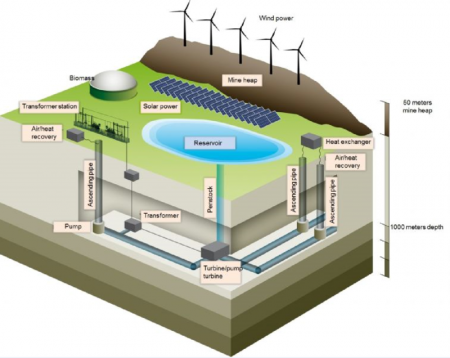April 1, 2017 – Germany after Fukushima decided to decommission its nuclear power plants. This put the country on an accelerated path to develop renewable energy capacity through solar, wind, geothermal and hydroelectricity. But in the interim Germany has continued to mine coal and feed its many thermal power plants. But now Germany is in the process of shutting down coal mines and seeking to repurpose some of them if possible. One of those mines in operation since 1974, is located near the Dutch border. Called Prosper-Haniel, the plans are to shut it down in 2018. But the shutdown will be followed by the development of a giant battery power generating station using pumped storage.
What does pumped storage involve?
It is not a new concept and requires the creation of a water head at an elevation above a power generating facility. If you look at traditional hydroelectric facilities they usually can be found by a dam. The dam creates a water head and when the water is released it flows through penstocks (large pipes) connected to turbines, connected to generators. Dams today, however, are increasingly seen as ecologically unfriendly. But latent energy created by a water head continues to be a highly efficient model for power generation particularly.
Prosper-Haniel isn’t a hydroelectric power plant in the conventional sense. It doesn’t use a natural water source or a natural drop in elevation. Instead it features an artificial surface reservoir connected to a pipe descending into a coal mine. To energy potential of the vertical shaft, some 1,200 meters (just under 4,000 feet) in depth converts the kinetic energy of the water into electricity.
Prosper-Haniel is not the first pumped storage facility to be built on a former mining site. Back in September of last year I described the Kidston pumped storage project, under development at a former Australian gold mine. At Kidston both the water head reservoir and the receiving reservoir are located on the surface. Ther vertical drop between them is 40 meters (130 feet). So the power generating potential of Kidston is less than that of Prosper-Haniel which is expected to produce 200 Megawatts. Kidston and Prosper-Haniel are both adjuncts to renewable power from other sources. In the case of the former the facility includes a large solar array. In the latter, there is a combination of wind turbines and solar panels. In both cases, the facilities are acting as large storage batteries.
At Prosper-Haniel water stored in the surface reservoir will flow through a penstock into the mine tunnels below where 26 kilometers (16 miles) of pipe will carry it to turbines connected to generators. The facility will transport a million cubic meters (over 35 million cubic feet) of water daily.
When wind, and solar power lulls occur, the pumped storage will kick in to smooth the delivery of electricity through Germany’s national grid. And during low power demand the solar and wind facility will power pumps to return water to the surface reservoir.
For the Ruhr and Rhineland regions of Germany the repurposing of phased out coal mines will help the region meet its 30% renewable power mix objective by 2025. Today the region produces 33% of Germany’s total power.
















